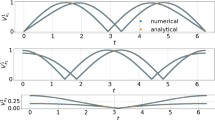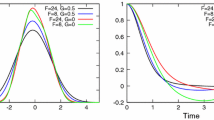Abstract
We develop and test two novel computational approaches for predicting the mean linear response of a chaotic dynamical system to small change in external forcing via the fluctuation–dissipation theorem. Unlike the earlier work in developing fluctuation–dissipation theorem-type computational strategies for chaotic nonlinear systems with forcing and dissipation, the new methods are based on the theory of Sinai–Ruelle–Bowen probability measures, which commonly describe the equilibrium state of such dynamical systems. The new methods take into account the fact that the dynamics of chaotic nonlinear forced-dissipative systems often reside on chaotic fractal attractors, where the classical quasi-Gaussian formula of the fluctuation–dissipation theorem often fails to produce satisfactory response prediction, especially in dynamical regimes with weak and moderate degrees of chaos. A simple new low-dimensional chaotic nonlinear forced-dissipative model is used to study the response of both linear and nonlinear functions to small external forcing in a range of dynamical regimes with an adjustable degree of chaos. We demonstrate that the two new methods are remarkably superior to the classical fluctuation–dissipation formula with quasi-Gaussian approximation in weakly and moderately chaotic dynamical regimes, for both linear and nonlinear response functions. One straightforward algorithm gives excellent results for short-time response while the other algorithm, based on systematic rational approximation, improves the intermediate and long time response predictions.
Similar content being viewed by others
References
Abramov, R., Majda, A.: Quantifying uncertainty for non-Gaussian ensembles in complex systems. SIAM J. Sci. Comput. 26(2), 411–447 (2003)
Bell, T.: Climate sensitivity from fluctuation dissipation: Some simple model tests. J. Atmos. Sci. 37(8), 1700–1708 (1980)
Carnevale, G., Falcioni, M., Isola, S., Purini, R., Vulpiani, A.: Fluctuation-response in systems with chaotic behavior. Phys. Fluids A 3(9), 2247–2254 (1991)
Cohen, B., Craig, G.: The response time of a convective cloud ensemble to a change in forcing. Q. J. R. Metorol. Soc. 130(598), 933–944 (2004)
Eckmann, J., Ruelle, D.: Ergodic theory of chaos and strange attractors. Rev. Mod. Phys. 57(3), 617–656 (1985)
Evans, D., Morriss, G.: Statistical Mechanics of Nonequilibrium Liquids. Academic Press, New York (1990)
Gritsoun, A.: Fluctuation–dissipation theorem on attractors of atmospheric models. Russ. J. Numer. Math. Model. 16(2), 115–133 (2001)
Gritsoun, A., Branstator, G.: Climate response using a three-dimensional operator based on the fluctuation–dissipation theorem. J. Atmos. Sci. 64(7), 2558–2575 (2007)
Gritsoun, A., Dymnikov, V.: Barotropic atmosphere response to small external actions. Theory and numerical experiments. Atmos. Ocean Phys. 35(5), 511–525 (1999)
Gritsoun, A., Branstator, G., Dymnikov, V.: Construction of the linear response operator of an atmospheric general circulation model to small external forcing. Num. Anal. Math. Model. 17, 399–416 (2002)
Haven, K., Majda, A., Abramov, R.: Quantifying predictability through information theory: Small sample estimation in a non-Gaussian framework. J. Comput. Phys. 206, 334–362 (2005)
Kubo, R., Toda, M., Hashitsume, N.: Statistical Physics II: Nonequilibrium Statistical Mechanics. Springer, New York (1985)
Leith, C.: Climate response and fluctuation–dissipation. J. Atmos. Sci. 32, 2022–2025 (1975)
Lorenz, E.: Predictability: A problem partly solved. In: Proceedings of the Seminar on Predictability, Shinfield Park, Reading, England. ECMWF (1996)
Lorenz, E., Emanuel, K.: Optimal sites for supplementary weather observations. J. Atmos. Sci. 55, 399–414 (1998)
Majda, A., Abramov, R., Grote, M.: Information Theory and Stochastics for Multiscale Nonlinear Systems. CRM Monograph Series of Centre de Recherches Mathématiques, Université de Montréal, vol. 25. AMS, Providence (2005). ISBN 0-8218-3843-1
Orszag, S., McLaughlin, J.: Evidence that random behavior is generic for nonlinear differential equations. Physica D 1, 68–79 (1980)
Risken, F.: The Fokker–Planck Equation, 2nd edn. Springer, New York (1988)
Ruelle, D.: Differentiation of SRB states. Commun. Math. Phys. 187, 227–241 (1997)
Ruelle, D.: General linear response formula in statistical mechanics, and the fluctuation–dissipation theorem far from equilibrium. Phys. Lett. A 245, 220–224 (1998)
Young, L.-S.: What are SRB measures, and which dynamical systems have them? J. Stat. Phys. 108(5–6), 733–754 (2002)
Author information
Authors and Affiliations
Corresponding author
Rights and permissions
About this article
Cite this article
Abramov, R.V., Majda, A.J. New Approximations and Tests of Linear Fluctuation-Response for Chaotic Nonlinear Forced-Dissipative Dynamical Systems. J Nonlinear Sci 18, 303–341 (2008). https://doi.org/10.1007/s00332-007-9011-9
Received:
Accepted:
Published:
Issue Date:
DOI: https://doi.org/10.1007/s00332-007-9011-9




